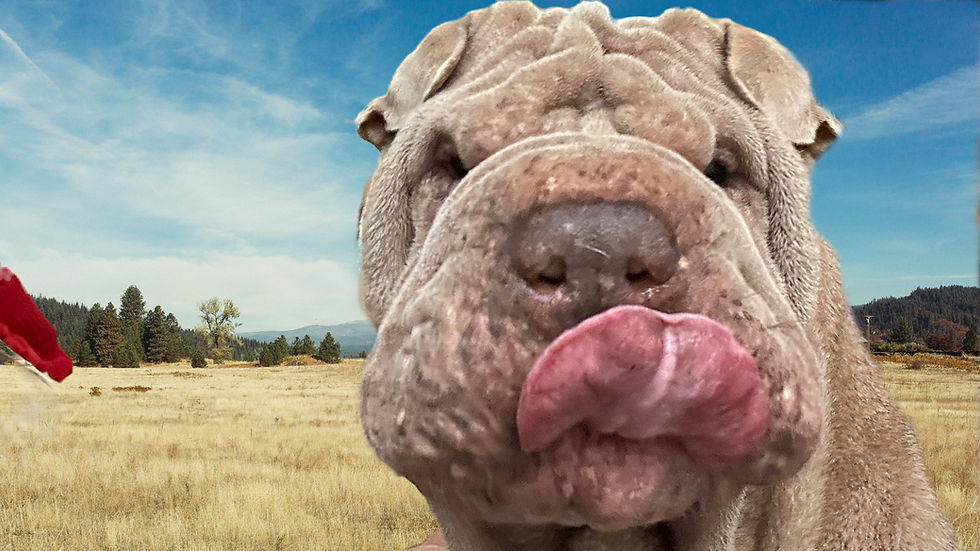The Weird and the Wonderful
- Helen Dale

- Jun 2
- 8 min read
Hi, Lets look at the benefits of feeding as much variety in a diet as possible. Whatever
processing style you choose to feed your dogs, raw, lightly cooked, freeze dried, dehydrated, canned, air dried, baked, dried and semi moist.
There are many different proteins. We have fed our pets so much chicken and beef over the
years, now they are the proteins most associated with allergies. Not all pets are allergic to chicken anf beef and sometimes it is blamed on these proteins without proper evidence it can also be what the animals are eating and plus these animals are over
breed. Living stressful lives and often a poor diet. Grass fed and free range gives a higher
nutrient meat with sometimes less allergic reactions ( grass fed beef = more omega 3 less
inflammatory or corn grain = more omega 6 more inflammatory) and even the type of soil they pasture on, changes the nutrient value of the meat.
Different meats give different nutrients, different flavors, different textures and different food
energetics.
It is also important to feed different parts of the animal.
Muscle meat which is muscle is important and can also include gizzards, heart, lungs and
tripe.
Organ meats these are the secreting organs, liver, kidney, brain, eyes, testicle, pancreas,
spleen.
Bones, never feed weight bearing bones as a food source these are more for recreational
cleaning any meat off from them. If you have a dog who can handle a harder bone and is a
gentle chewer. Recreational bones can be good but all bones have the possability to crack a tooth.
Never feed cooked bone.Or dried bones that could splinter.
Just like protein and organs that are different in nutrients from one animal to another, bones
differ in minerals and calcium content, not only the type of animal but the part of animal bone. (a neck bone is different to a wing to a foot etc )
Then the tendons, keratin, tongue, lips,
collagen and elastin awesome for joints, high in protein and low in fat another dog weight
watcher special and can be fed raw or lightly cooked. Raw is better as the lips can go a little hard rubbery. Dogs love them it’s a nice chewy flavoursome meat to add or give as a treat best cut when slightly frozen otherwise it like cutting rubber on the lip) hair, feathers, fur, cartilage,glands, They all serve a purpose.
The food with the most variety is not only more interesting for the dog but covers more
nutritional needs.
Some people think once you have found a food that works and they like it, then that’s the food for life, You can give dfferent options. You can even mix in a few different styles of processed.
As a raw feeder I have often used lightly cooked and freeze dried for meals. If you feed dried,try air dried or canned or slightly cooked. Some dogs won’t eat because they just get bored of one type of taste, smell and texture
First what do organs do?
A dog with pancreatitis benefits from eating PANCREAS as it has pancreatic enzymes. That is it’s job to help digest fats, it can get inflamed and overloaded with fats. Pancreatic enzymes help the inflamed pancreas digest fats. If you can’t find a food containing pancreas or pancreas on its own you can buy powered. Always check to see if your dog has pancreatitis with a vet as this can be chronic or acute. It helps sometimes just resting the pancreas with a very low fat diet and feeding an anti inflammatory diet can calm and works well. It is suggested that…cooked fats are much harder to digest than raw fats and oils as the pancreas has to work harder.
EYES are a less common organ. They have high amounts of DHA and even when feeding
small fish like sprats, sardines it’s best to feed whole as this includes the brain, eyes and skin.
All foods unless you DIY a raw diet will contain organ meat.
If organ meat isn’t in a complete balance meal or canned, dried food, supplementation will be included . Organs are the multivitamins of the body. Grass fed organs have a higher level of essential nutrients than grain fed.
LIVER, liver must be included (unless they can’t eat it or supplementation is added) it has the most concentrated source of vitamin A . Cooking liver will reduce some of the nutrients. Liver. contains. Folic acid, B Vitamins, iron and copper. Liver should be 5% of the diet too much liver can cause a toxic amount of Vitamin A and in some dogs could get Copper storage disease.
Where too much Copper builds up in the liver ( humans get this too) so be careful to only give a few liver treats if you give liver treats . The body will tell you hay that’s too much by loose stools. Too much organ can cause loose stools too much bone can give constipation or white crumbly stools, individual dogs need individual amounts. If constant loose or hard stools get them checked out.
KIDNEY- is most commonly used. Most premade diets have liver and kidney. Kidney is high in
Selenium and B Vitamins also a great source of Vitamin D
TESTICLES “The Rocky Mountain Oyster” not an oyster at all but a delicacy for humans.
These were and still are a special treat for cowboys in America and in many cultures.
These are great for Vitamin B especially B12 . I have fed testicles and you can buy online or sometimes at international stores.
. Warning they do smell a little but that just adds to the excitement
of dogs loving them . As they are organ meat only feed one or half a couple of times a week or you will get loose stools
THYMUS is not concentrated in minerals and vitamins although it does benefit from them it’s
power tool is it provides hormones for the immune function. When mixed with pancreas you
get sweetbreads . Sweetbreads were popular in the past when humans ate more organ meat.
They are popular in many cultures and still sold at butchers today.
BRAIN
Brain is 1-1 protein to fat it contains a source of DHA which is helpful to dogs who can’t have fish or shellfish .
SPLEEN the spleen filters the blood, produces white blood cells, controls the level of blood
cells, white, and red and platelets. Eating spleen gives you iron. Most diets do give enough
iron.
Beef spleen 1oz 12.6mg of iron
Lamb spleen 1oz 11.9mg of iron
Pork spleen 1 oz 6.3 mg of iron
GLANDS are for hormones
TRIPE is for iron too, a great tool for sensitive stomachs, it is highly nutritious and good for
gut health. It contains all essential amino acids and has a good phosphorus/calcium ratio
which makes it a good choice for dogs with kidney/renal disease. It is also an excellent choice for Potassium. It has anti inflammatory effects on the gut, antioxidants and it is said to have cardiovascular benefits. It contains enzymes and good bacteria Labobacillus and Acidophilus which live in the gut. An excellent way to improve the microbiome. Green tripe also has a good balance of omega 6 and omega 3 fatty acids. Only green tripe is used. You can get frozen or
canned tripe . Green tripe can also come dried as a chew ( l suggest you don’t
dehydrate this yourself as the smell is something else. l speak from experience. It kept me
awake all night lol) . You probably loose some of the probiotics in the drying but the texture of dried tripe as a treat makes a wonderful tooth brush for your dogs. In the wild thats how wild dogs and wolves get a little extra vegetation and fruit the best kind fermented in a ruminant’s gut . Don’t feed beef trip to dogs allergic to beef. It comes in a few different protein choices. I have heard talking about beef is some dogs that are allergic to beef are not allergic to the beef offal.This is true of my dog .Tripe is considered as a white meat, as apposed to a red meat with more myoglobin in it. This makes tripe easy protein to digest, it has less reactions and for dogs with leaky gutted, acid reflux it is believed to help the symptoms. It does contain histamine so go lightly if your dog has histamine issues.
Heart great for coq10 (beef hearts have the highest by far) and taurine. In my view a must for dogs and cats with heart issues.
Lungs excellent source of VitaminC, B12 and Zinc. Amongst others. Also a great low fat dried treat for dogs watching their weight. We have these in our stores.
Let’s add in some different nutrient profile, flavour and texture. No matter what style you feed give them at least 3-5 different proteins If feeding raw the more the better.
When giving a new protein it is best you mix it with the old protein and transition over a few
days ..
Novel proteins are the least allergic as they have the least intolerance . You find a protein, lets say turkey you feed turkey everyday for years . The body can build up an intolerance to turkey and became allergic . So mixing it up is beneficial.
So what can you feed? the list is long .
Stick with animals that aren’t carnivorous.
Here is a list some are harder to get, impossible to get and can be expensive to get . Mixing an
expensive protein amongst cheaper proteins makes a good balance .
In the first group are the proteins l have fed my dog ( I did live in America so some aren’t
available here) btw I have probably at some time cut up all animal parts so talk from
experience. I’m not suggesting you do, they often come already for use out the freezer or out
of a bag or can.
Bison, buffalo, beef, rabbit, beaver, beaver tail, chicken, turkey, duck, emu, ostrich, venison,
elk, caribou, alpaca, alligator, kangaroo, venison, water buffalo, boar ,frogs legs, Guinea fowl,
goat, goose, lamb, mutton, pheasant, Partridge and quail.
Can feed but haven’t camel, squirrel, pigeon, muskrat, insects and lm sure there are many
others, horse (wild drug free ponies).
Lets not forget fish I have fed wild salmon (always wild salmon or Scottish salmon),whitefish ,cod. As add ons not whole meals crab, black/blue mussels, oysters, squid, sprats, sardines,mackerel, Atlantic herring, smelt, shrimp, green lipped mussel . When feeding raw fish or meat they must be frozen for a few weeks first and best from a pet food company as they are safety checked. Muscles, crab, squid, oysters, l would always cook/ steam, dehydrate.In store there are a great range of frozen sprats and a very good green lipped
muscle oil ( the benefits of GLM are a whole blog on its own)
Mussels and green tripe give manganese so a useful ingredient to feed especially in
raw diets. Manganese also comes from fur and feathers,
Oysters which l find harder to get in the UK are high in zinc with 25.7mg per 1 oz.
I have spoken with many people and am always surprized at the amount of people who didnt know they could eat a different protien . People are so scared of dogs poop, they dont want to upset the consitency. You, me and anything not feed by us. dont have the same poop every single day . The more we eat the better we are and it is alot more interesting having different flavours and textures.



Comments